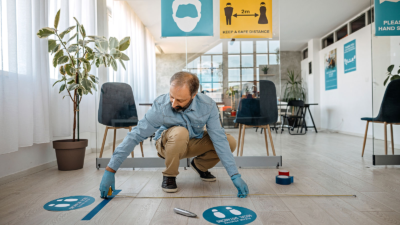‘After Yang’ explores the meaning of life through a broken android

[ad_1]
In the film After Yang, a father goes to great lengths to save his daughter’s best friend. It just so happens this bestie is a humanoid robot, or technosapien, named Yang. He’s practically a member of the family, but at the end of the day, he’s basically an appliance. Can he be easily replaced, and what’s the value of his artificial life? Like a cross between Black Mirror and Spike Jonze’s Her, After Yang explores humanity and existence through the lens of technology, while director Kogonada (Columbus) crafts a vision of the future that feels truly distinct.
After a virtuoso opening sequence, where families compete in a virtual dance contest in their living rooms, Yang (Justin H. Min) malfunctions. He’s not just some robotic butler; he’s a culture technosapien meant to help Jake’s adoptive daughter, Mika (Malea Emma Tjandrawidjaja), learn about her Chinese heritage. Mika has a stronger relationship with Yang, who practically raised her. And for reasons that aren’t clear at the start, Jake is a bit disconnected from his family and struggling through a mid-life crisis. (Running a traditional tea shop in the future would do that to you.) Saving Yang is both an attempt to connect to Mika, and to appease his overworked wife Kyra (Jodie Turner-Smith), who’s concerned about her listless husband.
Stories around artificial beings and androids aren’t anything new — they stretch back to early Jewish legends of golems, Mary Shelley’s Frankenstein, and Fritz Lang’s Metropolis. But these days, it feels as if it’s only a matter of time until we’re living alongside our own personal androids. Robotic vacuums are smarter and more affordable, we’re regularly shouting voice commands at our phones and smart appliances, and even Tesla claims it’s working on an AI-powered humanoid robot (though at this point, that’s basically just a marketing stunt). So it’s worth exploring how androids could affect our family lives, where they take on roles of childcare and companionship.
Jake’s journey to fix Yang isn’t much different than what we’d go through to get a computer or smartphone repaired today. He tries to contact the store he bought it from, but it’s no longer in business. Yang was also refurbished, which opens the door to surprising issues (something used electronics buyers are all too familiar with).
It turns out Yang had more than one previous owner, and he basically lived a long (and somewhat tragic) life. He was also an experimental model that could record small portions of memories, similar to the small bits of videos we see in Apple’s Live Photos. As Jake learns more about Yang, he realizes that he was a thinking being with a fully formed personality. He’s not just a helper bot following his programming, he was also endlessly curious about the world around him.
After Yang is a quiet film, filled with contemplative silences and Farrell’s forlorn eyes (not a bad thing, to be clear). Kogonada manages to build a world that feels dramatically different from our own, without the flashy holograms and special effects we see in lesser sci-fi films like the Ghost in the Shell remake. Everyone wears loose, robe-like outfits. There’s a strong Japanese influence throughout all of the environments, from the Muji-esque minimalism and organic materials in their homes, to natural wood and small gardens in self-driving cars. It’s a world far more advanced than ours — genetically optimized clones also appear — but it’s also in harmony with nature, like near-future sci-fi through the eyes of Hayao Miyazaki.
The fusion of the natural and man-made world mirrors the way an artificial being like Yang starts to become more human. It’s clear that he’s driven by some sort of artificial intelligence, but the film doesn’t say if his designers also managed to replicate a form of consciousness. Yang is programmed with facts about China, as well as language lessons for Mika, but he speaks more like a wise friend than a robotic teacher.
Like Blade Runner, it seems as if Yang is fully aware of his own limitations. He can show emotion and feelings towards people, but he probably doesn’t have the full range of human emotion. He also chases the unknowable, like the way Farrell’s character finds himself drawn to sell and explore the world of tea, even though he’s not a huge tea fanatic. It’s clear that both characters are searching for some meaning in their lives, but Yang has made peace with his existence in a way that Jake admires (and struggles with himself).
In a world where we actually have robotic companions, it’s not hard to imagine that we’d form deep bonds and mourn them when they’re gone. Losing your robot could eventually be as traumatic as losing a dear pet. But that would also reflect a world where our androids can also profoundly affect our lives. They’d be more than appliances – they’d be family.All products recommended by Engadget are selected by our editorial team, independent of our parent company. Some of our stories include affiliate links. If you buy something through one of these links, we may earn an affiliate commission.
[ad_2]
Source
Research Snipers is currently covering all technology news including Google, Apple, Android, Xiaomi, Huawei, Samsung News, and More. Research Snipers has decade of experience in breaking technology news, covering latest trends in tech news, and recent developments.












